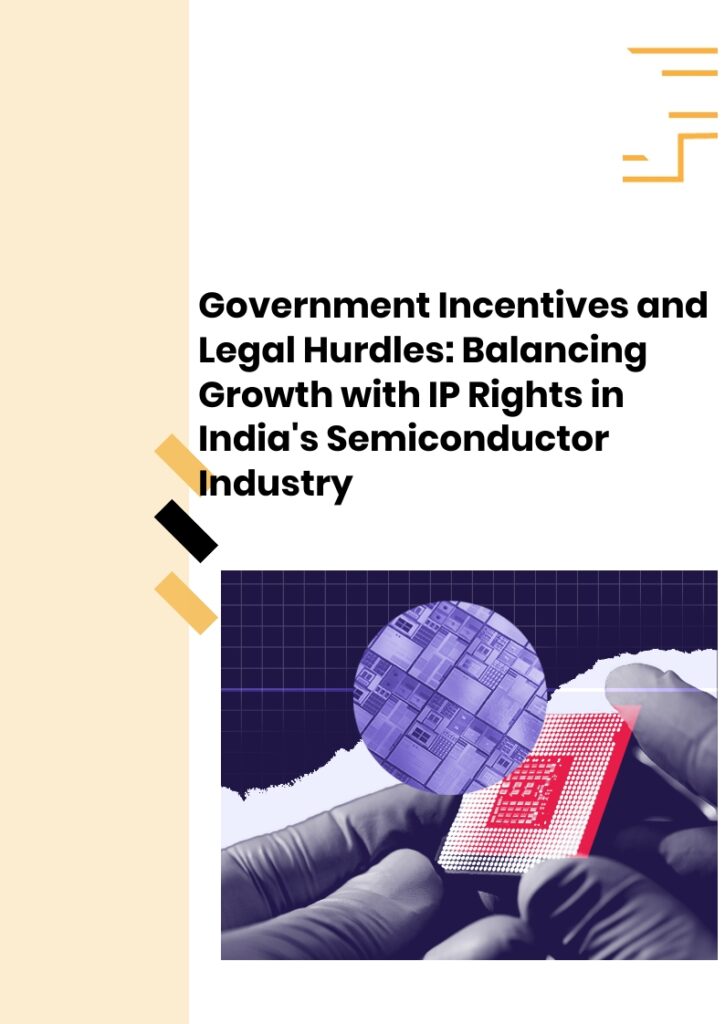
Introduction
India’s semiconductor industry is on the cusp of significant growth, driven by government initiatives aimed at boosting domestic manufacturing. The government’s push for self-reliance in semiconductor production aligns with the global trend of securing supply chains and fostering technological sovereignty. However, balancing this growth with the protection of intellectual property (IP) rights, particularly those of foreign technology providers, presents a complex challenge. This article explores mechanisms for efficient and fair dispute resolution concerning IP ownership and technology transfer agreements and discusses how the government can ensure effective technology transfer alongside foreign investment in domestic chip manufacturing.
Government Incentives for Semiconductor Manufacturing
India has introduced various incentives to attract investment in the semiconductor sector, recognizing its critical importance for technological advancement and economic growth. These incentives include:
- Financial Subsidies: Direct financial support to companies setting up semiconductor manufacturing plants.
- Tax Breaks: Tax exemptions and deductions to reduce the financial burden on semiconductor companies.
- Infrastructure Support: Development of special economic zones (SEZs) and technology parks with advanced infrastructure.
- Skilled Workforce Development: Initiatives to train and develop a skilled workforce tailored to the needs of the semiconductor industry.
These incentives aim to create a favorable environment for domestic and foreign companies to invest in India’s semiconductor ecosystem.
Legal Hurdles in IP Protection
Despite the attractive incentives, several legal hurdles persist, particularly concerning IP rights. Key challenges include:
- IP Ownership Disputes: Disagreements over the ownership of IP developed through joint ventures or partnerships.
- Technology Transfer Issues: Difficulties in ensuring that technology transfer agreements are respected and enforced.
- Inconsistent Enforcement: Variability in the enforcement of IP laws, leading to uncertainty and increased risk for foreign investors.
- Prolonged Litigation: Lengthy and complex litigation processes can deter investment and stifle innovation.
Mechanisms for Efficient and Fair Dispute Resolution
To address these challenges, it is essential to establish mechanisms for efficient and fair dispute resolution concerning IP ownership and technology transfer agreements. Some proposed mechanisms include:
- Specialized IP Courts
- Establishment of Courts: Create specialized IP courts with judges trained in semiconductor technology and IP law.
- Fast-Track Procedures: Implement fast-track procedures for resolving IP disputes to minimize delays and costs.
- Arbitration and Mediation
- Arbitration Panels: Develop arbitration panels specifically for semiconductor disputes, involving experts in technology and IP law.
- Mediation Services: Provide mediation services to facilitate amicable resolutions before disputes escalate to litigation.
- Clear Contractual Frameworks
- Standardized Agreements: Develop standardized technology transfer and IP ownership agreements to reduce ambiguity and conflict.
- Pre-Negotiated Clauses: Include pre-negotiated clauses for dispute resolution, specifying the jurisdiction, applicable law, and arbitration procedures.
- Regulatory Bodies
- Dedicated Regulatory Authority: Establish a regulatory authority to oversee IP-related issues in the semiconductor industry.
- Compliance Monitoring: Ensure ongoing compliance with IP laws and technology transfer agreements through regular audits and inspections.
Ensuring Effective Technology Transfer
Effective technology transfer is crucial for the success of foreign investment in domestic chip manufacturing. The government can take several steps to facilitate this process:
- Collaborative R&D Programs
- Joint Research Initiatives: Promote collaborative research and development programs between domestic companies and foreign technology providers.
- Funding Support: Provide funding support for joint R&D projects to encourage innovation and technology sharing.
- Public-Private Partnerships (PPPs)
- Incentivizing Partnerships: Offer incentives for public-private partnerships that focus on technology transfer and capacity building.
- Shared Resources: Facilitate the sharing of resources, such as research facilities and technical expertise, between public institutions and private companies.
- Skilled Workforce Development
- Training Programs: Invest in training programs to develop a workforce skilled in the latest semiconductor technologies.
- Industry-Academia Collaboration: Encourage collaboration between industry and academic institutions to align curricula with industry needs.
- Intellectual Property Exchange
- IP Exchange Platforms: Establish platforms for the exchange of IP, where companies can license or sell their innovations.
- Fair Licensing Terms: Ensure that licensing terms are fair and transparent to encourage the sharing of technology.
Balancing IP Protection with Foreign Investment
Balancing the need for robust IP protection with the goal of attracting foreign investment is a delicate task. The following strategies can help achieve this balance:
- Strengthening IP Laws
- Comprehensive Legislation: Update and strengthen IP laws to provide robust protection for both domestic and foreign innovators.
- Effective Enforcement: Ensure consistent and effective enforcement of IP laws to build investor confidence.
- Transparent Policies
- Clear Guidelines: Develop clear guidelines for IP protection and technology transfer to reduce uncertainty for foreign investors.
- Policy Consistency: Maintain consistency in policy implementation to provide a stable investment environment.
- Incentivizing Compliance
- Tax Incentives: Offer tax incentives for companies that comply with IP laws and engage in technology transfer.
- Recognition Programs: Establish recognition programs for companies that demonstrate best practices in IP management and technology sharing.
- International Collaboration
- Bilateral Agreements: Negotiate bilateral agreements with key countries to ensure mutual recognition and enforcement of IP rights.
- Global Standards: Align domestic IP laws with international standards to facilitate cross-border collaboration and investment.
Case Studies: Lessons from Other Countries
Examining the experiences of other countries can provide valuable insights into how India can balance IP protection with foreign investment in the semiconductor industry.
- South Korea
- Innovation Hubs: South Korea has established innovation hubs and technology parks that facilitate collaboration between domestic and foreign companies.
- Strong IP Enforcement: The country has a robust IP enforcement framework that protects the interests of all stakeholders.
- Taiwan
- Public-Private Collaboration: Taiwan’s success in the semiconductor industry is attributed to strong public-private collaboration and a focus on R&D.
- IP Frameworks: The country has developed comprehensive IP frameworks that support technology transfer and protect innovators.
- China
- Incentive Programs: China has implemented aggressive incentive programs to attract foreign investment and foster domestic innovation.
- IP Reforms: Recent IP reforms have strengthened protection and enforcement, making the country more attractive to foreign investors.
Conclusion
Balancing growth in the semiconductor industry with the protection of intellectual property rights is essential for fostering innovation and attracting foreign investment. India’s government incentives for semiconductor manufacturing are a step in the right direction, but addressing legal hurdles and ensuring effective technology transfer are crucial for sustained growth.
By establishing specialized IP courts, promoting arbitration and mediation, and developing clear contractual frameworks, India can create an environment conducive to innovation and investment. Ensuring effective technology transfer through collaborative R&D programs, public-private partnerships, and skilled workforce development will further strengthen the industry.
Balancing IP protection with foreign investment requires robust IP laws, transparent policies, and international collaboration. Learning from the experiences of other countries can provide valuable insights and help India navigate the complexities of IP protection and technology transfer.
Ultimately, protecting innovation while fostering growth in the semiconductor industry will position India as a global leader in technology and pave the way for a prosperous future in the digital age.





